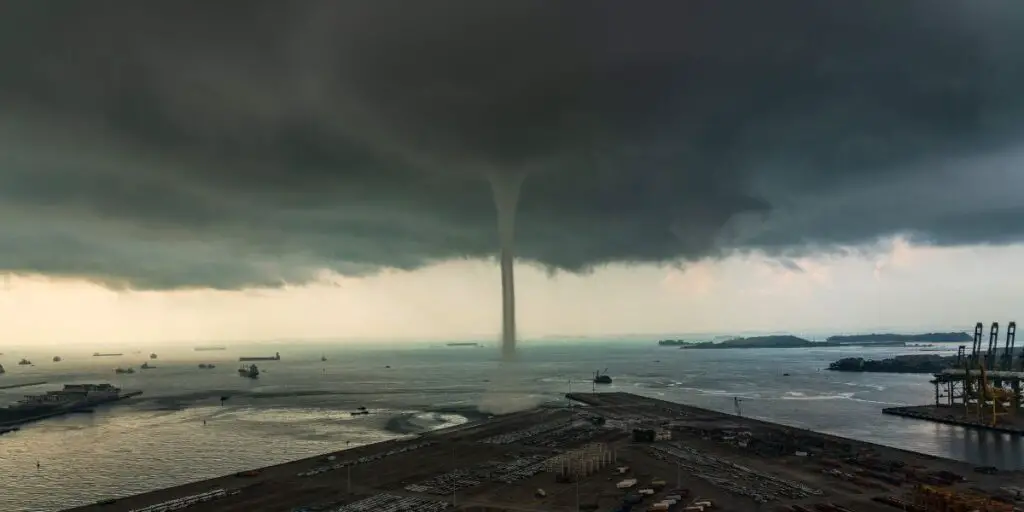10 Documentaries on Tornadoes That Will Blow Your Mind
Dive into the fascinating world of tornadoes with these 10 documentaries on tornadoes. Explore their science, history, and impact in a thrilling and educational journey. Get ready to be amazed!
Introduction: Tornadoes are one of nature’s most mesmerizing and terrifying displays of power. These swirling vortices of air can cause immense destruction and leave lasting impacts on communities and individuals.
With their unpredictable nature and awe-inspiring intensity, tornadoes have fascinated scientists, filmmakers, and storm enthusiasts alike. If you’re intrigued by the sheer force and beauty of tornadoes, look no further!

In this article, we have curated a list of 10 documentaries on tornadoes that will take you on an unforgettable journey into the heart of these natural wonders. So, grab your popcorn and get ready for an adrenaline-pumping adventure!
10 Documentaries on Tornadoes: Unleashing the Fury of Nature
1. The Deadliest Tornadoes Of All Time
“The Deadliest Tornadoes Of All Time | Mega Disaster |” explores the topic of tornadoes, delving into their unpredictable nature and the immense devastation they can inflict.
The video sheds light on the Fujita scale, a system used to measure tornado strength based on estimated wind speeds. It follows the account of a tornado that struck Attica, Kansas in 2004, with storm chasers diligently tracking and documenting the formation of multiple tornadoes spawned by the storm.
The video also underscores the critical importance of tornado warnings and taking immediate cover to safeguard lives. The tornado that hit Attica was estimated to be an F4 tornado, with wind speeds reaching a staggering 400 kilometers per hour, resulting in extensive destruction.
2. May 3rd – Deadly Force
The documentary “May 3rd – Deadly Force” chronicles the devastating impact of a severe tornado that ravaged Oklahoma on May 3rd.
The film showcases gripping footage captured by storm trackers, including Ranger 9, who ventured into the field to document the monstrous size and unparalleled destructive power of the tornado.
Meteorologists on the ground provide regular updates on the tornado’s trajectory and intensity, urgently warning viewers of the extreme danger it poses. The tornado is described as a wedge tornado, known for its immense size and formidable power, which resulted in injuries in Grady County.
The documentary underscores the critical importance of seeking shelter immediately for those in the path of such a destructive force of nature.
3. The Most Destructive Tornadoes In History
The documentary “The Most Destructive Tornadoes in History” discusses the unpredictable and destructive nature of tornadoes.
It explains that tornadoes are measured on the Fujita scale, with F5 being the most severe, and that they are more frequent in “Tornado Alley,” a region in the United States with ideal atmospheric conditions for tornado formation.
The documentary highlights a specific tornado that hit Attica, Kansas in 2004, and the devastation it caused.
It mentions that storm chasers track tornadoes using mobile Doppler radar and report information to meteorologists, including the tornado’s wind speed, location, and the number of tornadoes produced by a single storm.
The documentary emphasizes the importance of heeding tornado warnings and taking cover to save lives.
4. Tornado Alley – Real Time Tornado: Joplin, Missouri
The Joplin tornado, which occurred on May 22, 2011, was a catastrophic EF5 tornado, the highest rating on the Enhanced Fujita (EF) scale. It ripped through the city of Joplin, leaving a path of devastation in its aftermath.
The tornado resulted in 158 fatalities, and over a thousand injuries, and caused extensive damage to homes, businesses, and infrastructure.
The documentary “Real Time Tornado: Joplin, Missouri” provides a firsthand account of the events that unfolded during this devastating tornado, capturing the chaos and destruction in real-time.
5. Angry Skies
In the documentary “Angry Skies,” you will learn about the power and devastation of wind in severe storms like hurricanes and tornadoes. The documentary features brave storm chasers who risk their lives to capture footage of these deadly winds.
They highlight Hurricane Charley, a category 4 hurricane that hit Florida in 2004, as an example of the destructive force of the wind, causing billions of dollars in damages and leaving many people homeless.
You will also learn about the windiest place on Earth, Mount Washington in New Hampshire, where wind speeds can exceed hurricane speeds on over 100 days a year.
The documentary explores how wind affects humans, including an experiment in a wind tunnel that shows the effects of wind speeds equivalent to different categories of hurricanes on a person’s ability to stand unsupported.
This experiment demonstrates the immense power of wind and its potential to cause serious damage.
So, if you’re curious about the fascinating and sometimes destructive force of the wind in severe storms, be sure to watch the documentary “Angry Skies.” You’ll gain a deeper understanding of the power of wind and the risks that storm chasers take to capture its raw intensity on film.
6. Uncovering The World’s Biggest And Most Violent Storms “Stormrider: Tornado”
In the documentary “Stormrider: Tornado,” you will witness the incredible power and destructiveness of tornadoes, which are described as more powerful than man-made bombs and capable of causing widespread devastation.
Filmmaker Chris Terrell fearlessly confronts nature head-on as he captures extreme footage of these awe-inspiring yet dangerous natural phenomena.
The documentary features compelling interviews with experienced storm chasers who track tornadoes in tornado alleys across America. Through their firsthand accounts, you will gain insights into the thrilling and perilous pursuit of tornadoes.
Additionally, the documentary includes interviews with residents of Greensburg, a community in Kansas that was struck by a massive tornado in 2007. These personal accounts showcase the devastating impact of tornadoes on communities and individuals.
“Stormrider: Tornado” also delves into the high-tech methods used by storm chasers to track tornadoes, providing a glimpse into the tools and technologies they employ to monitor and predict tornado activity.
However, the documentary also emphasizes the risks involved in chasing tornadoes, highlighting the dangers and challenges that storm chasers face in pursuit of their passion.
Prepare to be mesmerized by the breathtaking footage and compelling stories in “Stormrider: Tornado” as you gain a deeper understanding of the raw power and destruction unleashed by these natural forces. Experience the thrill and intensity of tornadoes through the lens of Chris Terrell’s documentary.
7. SuperTornado: Anatomy of a Megadisaster
In the documentary “SuperTornado: Anatomy of a Megadisaster,” you will delve into the aftermath of the devastating tornado that struck Joplin, Missouri on May 22, 2011. This tornado stands out as one of the most costly and deadliest in history, leaving behind widespread destruction, loss of life, and injuries.
The documentary sheds light on the tireless efforts of scientists who studied the Joplin tornado to better understand its destructive nature and develop strategies to protect communities from future tornadoes.
You will gain insights into the cutting-edge technologies used by the National Weather Service, including satellites, Doppler radars, and computer models, to monitor and predict severe weather patterns.
Supercomputers are also utilized by scientists to simulate tornadoes and study their formation, providing valuable data for research and mitigation efforts.
The documentary further explores the impact of urbanization and population growth in tornado-prone areas, which have heightened the potential for large-scale disasters. You will learn about the challenges faced by communities in tornado-prone regions and the ongoing efforts to enhance preparedness, response, and recovery measures.
Prepare to be immersed in the scientific study of tornadoes and the critical role of advanced technologies in monitoring, predicting, and mitigating their impact. “SuperTornado: Anatomy of a Megadisaster” provides a thought-provoking perspective on the anatomy of tornadoes and the ongoing efforts to safeguard communities from their devastating effects.
8. 1966 Topeka Tornado: Path of Disaster
In the documentary, “The 1966 Topeka Tornado: A Devastating Force,” you will learn about the catastrophic tornado that struck Topeka, Kansas. This tornado ravaged residential neighborhoods before moving on to the city center, leaving behind widespread destruction in its wake.
Despite the belief among many residents that they were protected by Burnett’s Mound, a hill thought to have mystical powers and act as a physical barrier against tornadoes, the tornado struck the city, causing extensive damage. This was a stark realization that no physical barrier could withstand the force of a powerful tornado.
The tornado was initially detected by a local law student and newscaster who was filling in for a friend. At the time, the National Weather Service relied on limited radar technology, and the tornado was only confirmed after it touched down and registered debris in the air.
The documentary features firsthand accounts from survivors, providing insights into their harrowing experiences during and after the tornado. You will hear stories of homes, buildings, and vehicles being destroyed, and how many residents sought shelter in crawl spaces or basements to stay safe.
Through personal testimonies and historical records, “The 1966 Topeka Tornado: A Devastating Force” offers a poignant portrayal of the immense destruction caused by this tornado and the impact it had on the community. Prepare to hear gripping stories from survivors and gain a deeper understanding of the power and devastation of tornadoes.
9. Nature’s Fury: Tornadoes
“Nature’s Fury,” a documentary, delves into the power of natural disasters, particularly earthquakes, and their devastating effects on cities worldwide. It highlights the sudden and unpredictable nature of earthquakes, which can cause immense destruction and loss of life.
The documentary explains the science behind earthquakes, including how they are caused by the movement of tectonic plates and how they shape landscapes in regions like California.
It also examines the role of human infrastructure and building practices in earthquake vulnerability, using examples such as the 1906 San Francisco earthquake and the 1985 earthquake in Mexico City.
The documentary emphasizes the importance of preparedness and understanding the forces of nature in order to mitigate the risks posed by earthquakes.
10. The Survivors of The Deadly 1999 Oklahoma Tornado Outbreak
“The Survivors of The Deadly 1999 Oklahoma Tornado Outbreak” is a documentary that delves into the events surrounding the devastating tornado outbreak that occurred in Oklahoma in 1999.
The documentary discusses the warnings issued by meteorologists leading up to the outbreak, the efforts of rescuers who chased the storms, and the catastrophic impact of the tornadoes on communities in Oklahoma City.
It highlights the severity of the storms, the extensive damage caused by the tornadoes, and the valiant efforts of meteorologists and storm chasers to warn and rescue those in danger.
The documentary also addresses the complacency of some residents towards tornado warnings and the use of advanced technology such as Doppler radar and GPS to track and broadcast information about approaching storms.
As you watch the documentary, you will gain insight into the harrowing experiences of the survivors and the crucial role of preparedness and awareness in mitigating the devastating effects of tornadoes.
Causes and Formation of Tornadoes
Tornadoes form under specific atmospheric conditions that involve the interaction of warm, moist air and cold, dry air. When these air masses collide, it can create a rotating column of air known as a mesocyclone, which can then develop into a tornado.
The process of tornado formation is complex and still not fully understood, but researchers continue to study and analyze tornadoes to gain insights into their causes and behavior. Tornadoes can vary in size, intensity, and duration, and they are classified on the Enhanced Fujita (EF) scale based on the damage they cause.
Impacts of Tornadoes
The impacts of tornadoes can be devastating. Tornadoes can cause widespread damage to property and infrastructure, leveling buildings, uprooting trees, and damaging power lines.
The aftermath of a tornado can be chaotic, with debris scattered everywhere and communities left in disarray. Tornadoes can also result in human casualties and injuries, leaving a lasting impact on individuals and communities.
The psychological effects of experiencing a tornado, such as post-traumatic stress disorder (PTSD), can also be long-lasting and significant.
Forecasting and Warning Systems for Tornadoes
Predicting the occurrence of tornadoes is a challenging task, but advancements in technology and meteorological research have led to improved tornado forecasting techniques.
Meteorologists use various tools and data, such as Doppler radar, satellite imagery, and weather models, to monitor atmospheric conditions and identify potential tornado threats.
Storm chasers, who are trained experts in tracking severe weather, also play a crucial role in tornado forecasting by providing real-time observations and data.
Tornado warning systems are designed to alert communities at risk and provide them with enough time to take necessary precautions.
These systems include sirens, weather radios, and mobile alerts, which can warn people in the path of a tornado to seek shelter immediately.
However, despite the advancements in forecasting and warning systems, tornadoes can still be unpredictable and rapidly changing, making it essential for individuals and communities to be prepared and have a plan in place.
Conclusion
Tornadoes are awe-inspiring natural phenomena that can have devastating impacts on communities and individuals.
Documentaries on tornadoes offer a unique perspective on their science, history, and impact, showcasing the raw power and destructive force of these storms.
From thrilling adventures of storm chasers to in-depth scientific explanations, these documentaries provide a fascinating insight into the world of tornadoes.
FAQs:
Are tornadoes predictable?
Tornadoes can be challenging to predict accurately due to their rapidly changing and unpredictable nature. However, advancements in technology and meteorological research have improved tornado forecasting techniques, allowing for better warnings and preparedness.
How can I stay safe during a tornado?
The best way to stay safe during a tornado is to have a plan in place and be prepared. When a tornado warning is issued, seek shelter immediately in a small, windowless interior room on the lowest level of your home. Avoid windows and cover yourself with a mattress or heavy blankets for protection.
What is “Tornado Alley”?
“Tornado Alley” is a region in the United States that is known for having a higher frequency of tornadoes. It stretches from northern Texas to the Dakotas and includes states such as Oklahoma, Kansas, and Nebraska, among others.
Can tornadoes be prevented or stopped?
Tornadoes are natural phenomena that cannot be prevented or stopped. However, tornado warning systems, preparedness, and early warning systems can help mitigate the impacts and save lives.
What should I do after a tornado?
After a tornado, it’s crucial to prioritize safety and follow instructions from local authorities. Be cautious of hazards such as downed power lines and debris, and check on the well-being of yourself and others. Contact emergency services for assistance and begin the process of recovery and rebuilding.
Subscribe to our newsletter
Get Access To Our Latest Documentaries Before Everyone Else






